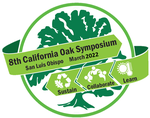#39

Post-fire Oak Survival and Regeneration in Oak Woodlands Impacted by the River Fire at Hopland Research and Extension Center
Michael I. Jones, UC Cooperative Extension, Mendocino, Lake and Sonoma Counties
In July 2018, the River Fire burned ~3,000 acres of oak (Quercus spp.) woodlands, chaparral, and grasslands at the Hopland Research and Extension Center. Fire behavior was highly variable across the site, resulting in a mosaic pattern of low to high burn severity. To assess how the fire impacted oak survival and regeneration, long-term monitoring plots were established in burned and unburned oak stands.
Data were collected on 468 trees representing seven oak species. At the time of plot establishment several months after the fire, 41.3% of oak trees in burned plots appeared dead (compared to 5.4% in unburned plots) with extensive bark charring, cambium damage, and > 90% canopy torching. However, new (post-fire) epicormic and/or basal sprouts were observed on 29.2% of trees that had high severity burn damage, suggesting observed mortality may have been limited to aboveground biomass.
Plots were reassessed November 2019 and apparent mortality (no evidence of regeneration) had decreased to 12.7%, while 81.0% of trees with high severity burn damage had basal or epicormic sprouting. Oak seedlings were often detected in plots with moderate to high burn severity. Deer browse and powdery mildew on basal sprouts was commonly observed. Evidence of insect feeding (galleries and exit holes) were observed on dead trees, but few signs of pests were detected on living trees or living tissue of fire stressed trees.
These results indicate even though many of the oak woodlands in this study appeared to have been significantly impacted by the River Fire, most trees with aboveground mortality were already regenerating through basal sprouting and there was abundant seedling recruitment. Continued monitoring will elucidate the success of regeneration and if continued injury from pests will have a lasting impact on new growth.
